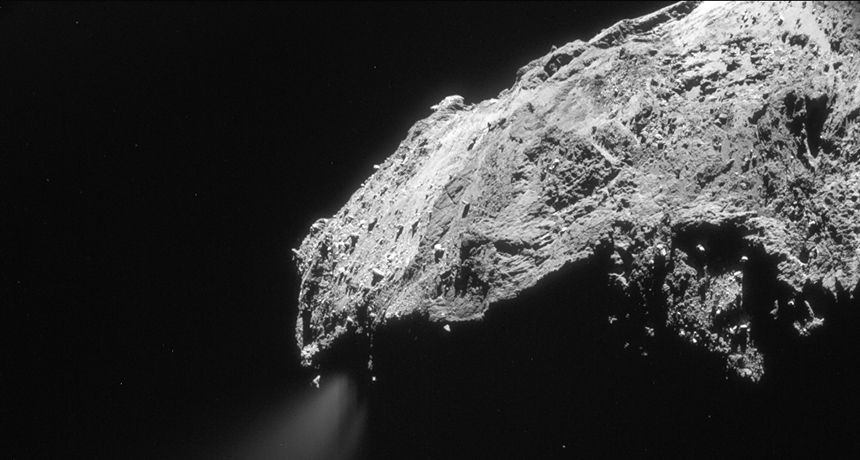Comets carried noble gases to Earth

Asteroids probably ferried water to an infant Earth (SN: 5/16/15, p. 18), but they weren’t responsible for our planet’s entire chemical inventory. Comets might have trucked in noble gases and much of the raw material needed for life, researchers suggest online March 9 in Earth and Planetary Science Letters.
Noble gases don’t play well with the other elements. They typically shun chemical reactions, which means their abundances haven’t changed much since the formation of the solar system. Comets are thought to be frozen relics from the birth of the planets, but until recently researchers didn’t know how much of any noble gas comets carried.
That changed shortly after the Rosetta spacecraft arrived at comet 67P/Churyumov-Gerasimenko in August 2014 (SN: 9/6/14, p. 8) and made the first measurement of argon in a cometary atmosphere. It’s not much — roughly 1/100,000 the amount of water — but it’s several orders of magnitude more than the abundance of argon in icy asteroids. And that’s enough for comets to have been a major source of argon (and presumably other noble gases) to Earth, Bernard Marty, a geochemist at Petrographic and Geochemical Research Centerin Vandœuvre-lès-Nancy, France, and colleagues report.
The delivery arrived during the Late Heavy Bombardment about 600 million years after the start of the solar system, Marty and collaborators suggest. That’s when the moon (and supposedly Earth) was pummeled by debris from the outer solar system as the giant planets abruptly settled into their current orbits.
Argon might seem of little relevance to everyday life. But “if argon came from comets, we can make some inferences about how much prebiotic material came in comets too,” Marty says. And those other goodies, such as amino acids, might matter a great deal. Assuming that all the argon in Earth’s atmosphere came from comets, and that cometary levels of amino acids (which no one has measured) are similar to what’s found in meteorites known as carbonaceous chondrites, the researchers calculated how much amino acids comets could have delivered to Earth. Dust collected from comet 81P/Wild 2 by the Stardust spacecraft in 2004 showed some chemical similarities between its quarry and those meteorites.
It’s a rough calculation, Marty admits, and it assumes that the deliveries survived the impacts. But the team estimates that the amount of amino acids supplied by comets could roughly equal the total mass found in all organisms from paramecia to plants and people.
“I think it’s an interesting exercise,” says Conel Alexander, a planetary scientist at the Carnegie Institution for Science in Washington, D.C. “But it’s full of so many uncertainties. My worries are that we still know so little about comet composition.” The amount of cometary argon, for example, is based on just one comet. Other comets have shown tremendous variability, for example, in the relative amounts of water isotopes. Researchers also don’t have a good handle on the concentration of other noble gases, such as xenon, lurking in comets.
There’s also uncertainty about the Late Heavy Bombardment that presumably brought the comets to Earth. Evidence for the influx of debris comes from a spike in craters on the moon roughly 4 billion years ago. But the timing comes from lunar rocks collected by Apollo astronauts and those samples might all have come from one basin, says Alexander. Rather than revealing the ages of many craters, the moon rocks might record the date of a single run-in with a giant intruder.
Recent computer simulations also indicate that the giant planet tango that allegedly triggered the bombardment should have removed at least one of the inner planets, which doesn’t appear to have happened. To avoid that catastrophe, the gas giants had to have settled down before the rocky planets finished forming and so wouldn’t have been available to fling things at Earth 600 million years later.